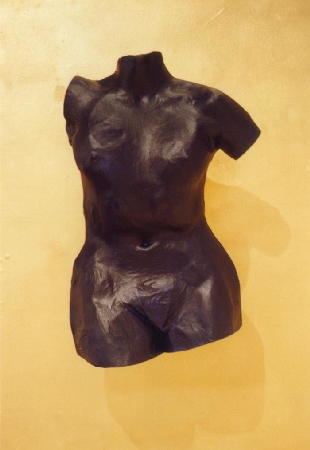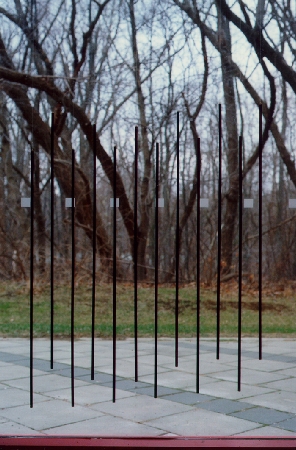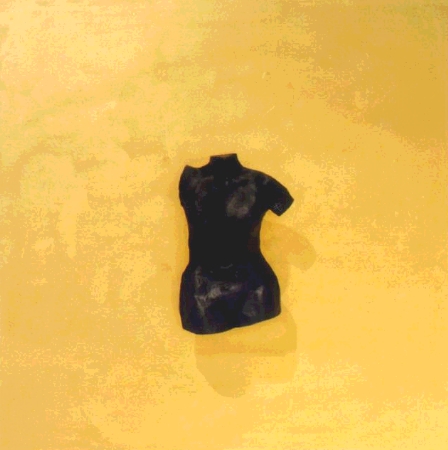| Back to show catalogue | ||
|
Blue Cast, Line-trap & Blue Rain - John Longden  PART
I: ANALYSIS(?) PART
I: ANALYSIS(?)
ė[In the beginning] pure colour, the universal soul in which the human soul was bathing in a state of earthly paradise, was mastered by the invasion of the line, imprisoned, compartmentalized, cut apart, returned to slavery. In the joy and delirium of its guileful victory, line subjugated man and imprinted upon him its abstract rhythm.' (Rice: 218) Thus begins Yves Klein's description of a binarizing war for supremacy between the opposed forces of line and colour. A conflict in which the artist would favour colour as a inevitable victor. Yet, as we shall see, this prophet of colour produced a small number of works that call this celebration into question. Works so extraordinarily linear that they threaten the unity of the prophet's message. The Sculpture Bleue, Pluie Bleue and Pluie Rouge all stand out as works in which colour has failed to subsume line and make it irrelevant. Before exploring the nature of these works it would perhaps be edifying to examine the nature of the conflict itself. By couching his introduction to the war between line and colour in terms of the earthly paradise Klein places his perceived conflict on the same level as creation, the temptation and the expulsion. In these terms then does the initial victory of line correspond to the beginning of linear time as thought to have begun at the moment of the expulsion? If this supposition is correct colour must then be the atemporal state in which we (humanity) were in intimate contact with the God-head prior to giving in to temptation. Time here would exist as a field that encompasses all yet allows movement in any direction within it. The iconic significances that flow from this sort of allegory are obvious. The serpent, most visually linear of God's creations, proves to be the tempter, seeking the expulsion of the first parents from the garden. The snake divides man and wife, placing them at odds before the Divine presence, his first act of transgression similar to the way the line divides colour from colour upsetting the primal purity of the atemporal Edenic state. What happens if the metaphoric connection to creation is extended? Colour, existing en potentia (perhaps even within the line itself?), somehow survives the expulsion and hundreds of years in the post-lapsarian (that is, post-Edenic) state, perpetually at war with the forces of the line, awaiting expectantly the coming of a messiah. This is the role in which Klein envisioned himself. Out of the struggle for primacy between line and colour Art is born. Since its birth Art has shown in itself the indelible marks of its birthright, wavering back and forth between valuation of each of its two parents. It is only natural then that the expected messiah should come from the among Art's adherents, from among the artists. Klein quite explicitly casts himself in this messianic role in the last paragraph of The War: A Little Personal Mythology of the Monochrome (Rice: 219.) As a Christ figure Klein must show the way back to the primal state. As Christ acts as a surrogate for mankind and through his actions illumines a path back to the congress with God, so must Klein, by example, light a path back to the garden in which the initial confrontation was played out. How will he go about this?
Pluie Bleue and Pluie Rouge further complicate this potential road back to Eden by once again reasserting the individual line. Covered in, but comprised of pigment, these lines are separated from one another, causing the field effect to be broken before it can begin... but is it really? By separating the lines in space Klein makes it much more difficult to perceive them as a unified whole, but not impossible. The uniform spacing of the lines allows the eye of the viewer pull them together as the dramatic power of the pigment vibrates outward to fill the intermediary spaces. Thus the Rain sculptures are perhaps even more effective than the monochromes or pigmented sculptures by virtue of their requiring the viewer to commit to thought and analysis in order to actualise the latent colour field. These ėrain drops' by their association with liquid in name reveal a fluidity in the identification of an individual mark as either line or colour. The painter/prophet
is revealed to have been blinkered by his zeal. His focus on one
of the primal pair at the expense of the other has strangled his ability
to step back and to look at the unity that exists between these elements
that he has perceived as opposites. The line is only colour in a
compressed space. Likewise the colour is line expanded and exploded
across a larger surface.
I am not certain
what the analysis portion of this paper reveals about my engagement with
Klein in the pieces explored and re-interpreted. While the blue painted
dowels of the Blue Rain lay drying on the living room floor I began to
perceive them not as individual sticks but as a pattern of parallel lines
and then eventually as the ėfield' I describe above. This image is
also the basis of my suggestion that colour is latent or present en potentia
in line. The bleeding together of the lines into the field could
not have occurred if this were not true. Perhaps this is the effect
Klein was looking for in the viewer but I tend to believe that this is
not actually the case. I think, based on his writings, that Klein
did indeed see an opposition of sorts between colour and line but perhaps
not on so grandiose a scale as his writing suggests. I think that
while he might not deny my reading he also might not endorse it either.
As always it is difficult to separate theatrics from sincere belief where
Klein is involved.
 READINGS READINGS
Stich, Sidra. Yves Klein. Exhibition Catalogue. Cantz Verlag, Stuttgart. 1994. Yves Klein: 1928 - 1962.
A Retrospective, Exhibition Catalogue. Institute for the Arts,
Rice University, Houston. The Arts Publisher, Inc., New York.
1982.
|
||
 The Sculpture Bleue appears physically to be a collection of sticks/lines
(these elements will be used interchangeably) gathered together on a small
boulder and presented in IKB to the viewer. Is the blue colour to
absorb the lines and lift them into the realm of colour? Perhaps,
but here the line still maintains the power to transgress the singular
purity of colour and manages to project its own existence in spite of its
covering of pigment. This does not, however, completely undo the
project that Klein has set out for himself. Klein has presented,
perhaps not completely consciously, both combatants in his ėWar' as facets
of one another. The line here is covered in pigment but is not a
line traditionally comprised of pigment as well? By collecting together
so many lines the artist creates the very beginnings of a visual field.
A field that he has impregnated, even at this fledgling stage, with colour.
The atemporal field is thus combined with the linear progression of time
in a new and interesting way. As facets of one another the potential
for ėsalvation' (an approach to the atemporal) exists in us all
The Sculpture Bleue appears physically to be a collection of sticks/lines
(these elements will be used interchangeably) gathered together on a small
boulder and presented in IKB to the viewer. Is the blue colour to
absorb the lines and lift them into the realm of colour? Perhaps,
but here the line still maintains the power to transgress the singular
purity of colour and manages to project its own existence in spite of its
covering of pigment. This does not, however, completely undo the
project that Klein has set out for himself. Klein has presented,
perhaps not completely consciously, both combatants in his ėWar' as facets
of one another. The line here is covered in pigment but is not a
line traditionally comprised of pigment as well? By collecting together
so many lines the artist creates the very beginnings of a visual field.
A field that he has impregnated, even at this fledgling stage, with colour.
The atemporal field is thus combined with the linear progression of time
in a new and interesting way. As facets of one another the potential
for ėsalvation' (an approach to the atemporal) exists in us all
 PART
II: HANDS ON
PART
II: HANDS ON